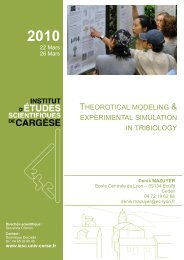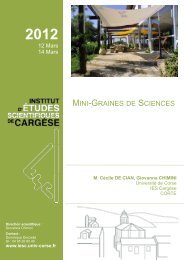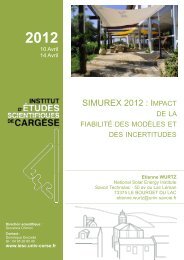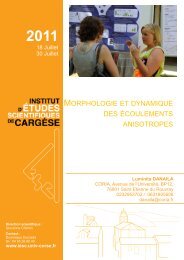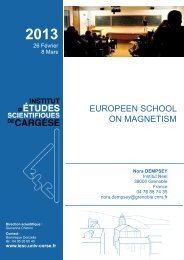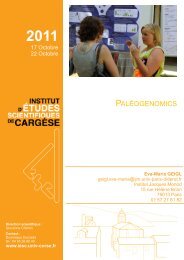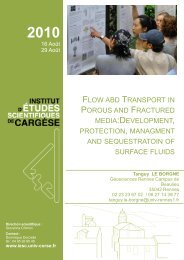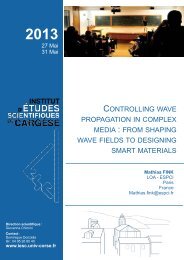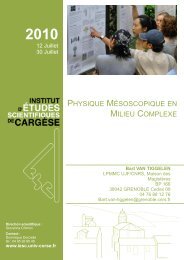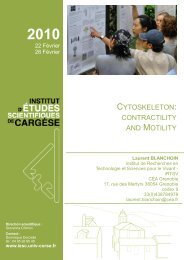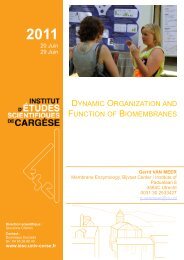nanoelectronics - Institut d'Études Scientifiques de Cargèse (IESC)
nanoelectronics - Institut d'Études Scientifiques de Cargèse (IESC)
nanoelectronics - Institut d'Études Scientifiques de Cargèse (IESC)
Create successful ePaper yourself
Turn your PDF publications into a flip-book with our unique Google optimized e-Paper software.
Wednesday<br />
Wednesday, October 24<br />
Thermoelectric properties of strongly correlated quantum systems<br />
Antoine Georges<br />
Collège <strong>de</strong> France, Paris - Ecole Polytechnique, Palaiseau, France - Université <strong>de</strong> Genève,<br />
Suisse<br />
Materials with strong electronic correlations, especially transition-metal oxi<strong>de</strong>s, have received<br />
increasing attention as possible thermoelectrics. An interesting regime is that of intermediate<br />
to high temperatures, where enough entropy is unquenched. I will <strong>de</strong>scribe here the<br />
theoretical un<strong>de</strong>rstanding of the temperature–<strong>de</strong>pen<strong>de</strong>nce of the Seebeck coefficient for<br />
simple mo<strong>de</strong>ls of interacting electrons, as well as selected experimental results. On another<br />
note, I will present a recent proposal for studying fundamental aspects of thermoelectric<br />
effects using ultra-cold atomic gases.<br />
__________________________________________________________________________<br />
Thermopower and thermoelectric efficiency in systems with broken time-reversal<br />
symmetry<br />
Giuliano Benenti<br />
Center for Nonlinear and Complex Systems, Università <strong>de</strong>gli Studi <strong>de</strong>ll'Insubria, Via Valleggio<br />
11, 22100 Como, Italy<br />
We show that in systems with broken time-reversal symmetry the maximum efficiency and<br />
the efficiency at maximum power are both <strong>de</strong>termined by two parameters: a ``figure of merit''<br />
which generalizes the thermoelectric figure of merit ZT, and an asymmetry parameter, which<br />
becomes relevant when the thermopower is not an even function of the magnetic field. In<br />
contrast to the time-symmetric case, the figure of merit is boun<strong>de</strong>d from above; nevertheless<br />
the Carnot efficiency can be reached at lower and lower values of the figure of merit as the<br />
asymmetry parameter increases. Moreover, the Curzon-Ahlborn limit for efficiency at<br />
maximum power can be overcome within linear response. We show that a weak magnetic<br />
field generally improves either the efficiency of thermoelectric power generation or of<br />
refrigeration, the efficiencies of the two processes being no longer equal when a magnetic<br />
field is ad<strong>de</strong>d. Finally, we discuss the thermopower asymmetry and thermoelectric efficiency<br />
for a three-dot ring pierced by an Aharonov-Bohm flux, for random matrix mo<strong>de</strong>ls, and for<br />
more abstract transmission mo<strong>de</strong>ls.<br />
[1] K. Saito, G. Benenti and G. Casati, A microscopic mechanism for increasing<br />
thermoelectric efficiency, Chem. Phys. 375, 508 (2010)<br />
[2] G. Benenti and G. Casati, Increasing thermoelectric efficiency: dynamical mo<strong>de</strong>ls unveil<br />
microscopic mechanisms, Phil. Trans. R. Soc. A 369, 466 (2011)<br />
[3] G. Benenti, K. Saito and G. Casati, Thermodynamic bounds on efficiency for systems with<br />
broken time-reversal symmetry, Phys. Rev. Lett. 106, 230602 (2011)



